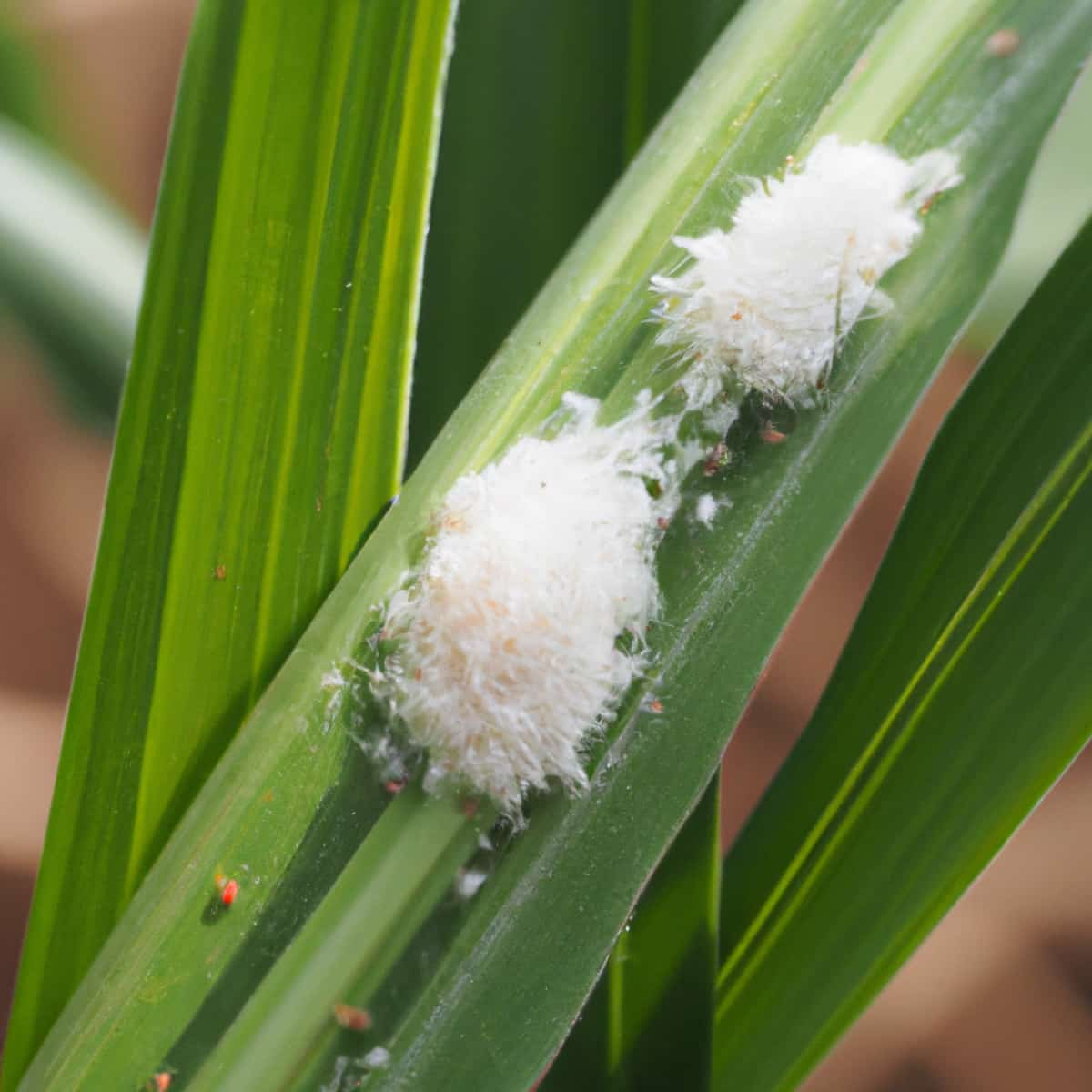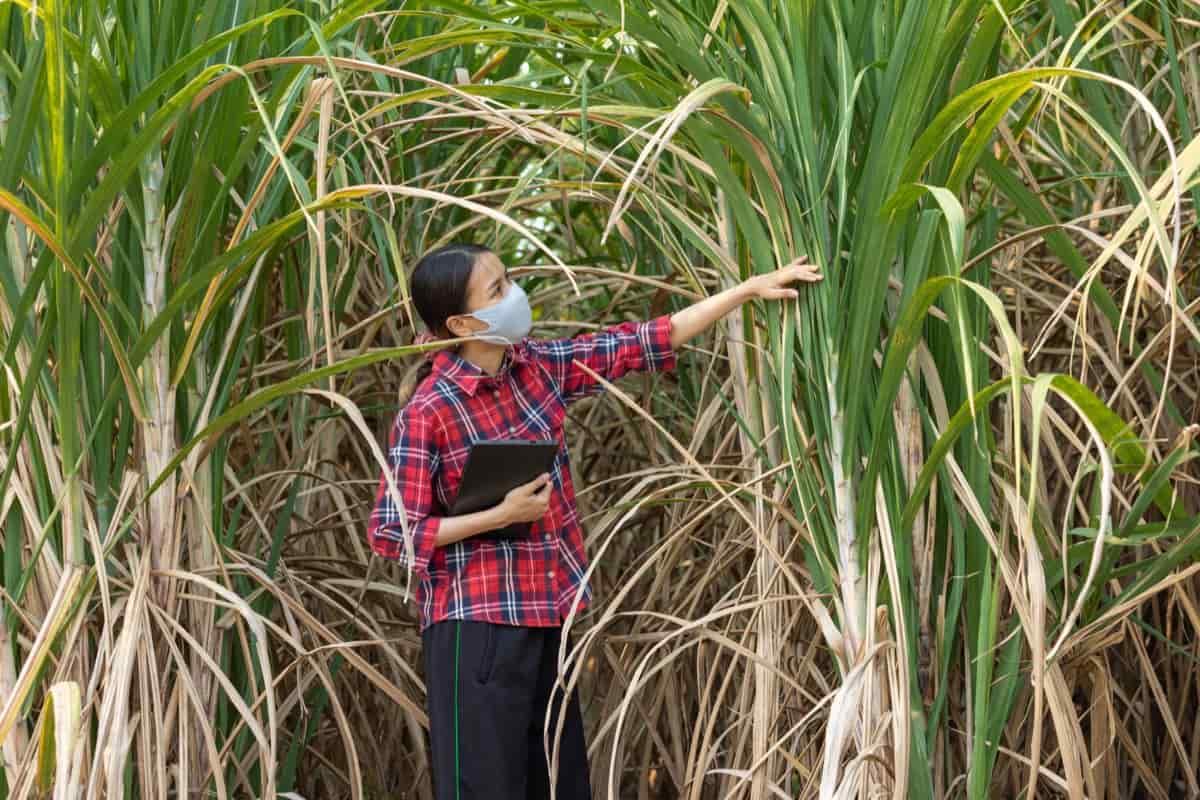Mealybugs are a big problem for sugarcane crops because they feed the sap from the canes. The saccharum mealybug (Saccharicoccus sacchari) is a species of mealybug that specifically affects sugarcane crops. It causes the crops to produce less sugar and lose money. The honeydew excreted by the insects can attract sooty mold, reducing the sugarcane leaves’ photosynthetic efficacy and causing leaf drops.

Severe infestations can cause leaves and flowers to fall off, sugar cane to set less sugar, and young fruit to die. All of these things hurt the quality of the final product. The honeydew not only brings in ants but also protects mealybugs from their natural enemies, making it hard to keep their numbers down.
Mealybugs that feed on sugarcane can inject poisons into the plant while they eat, causing deformations. Some species can even spread viruses, which causes even more crop damage. Effective management strategies, such as cultural and biological control methods, are essential for mitigating mealybug damage to sugarcane crops.
Mealybug Management in Sugarcane
Life Cycle of Mealybug
Mealybugs begin their life cycle with eggs that are yellow and cylindrical. The eggs remain in the female reproductive organs until they are nearly completely developed, and the incubation period is brief. The females are capable of producing hundreds of offspring through parthenogenesis. Before maturing into adults, the newly emerged nymphs undergo multiple molts and are quite active with a pinkish-transparent body. Adult mealybugs have a white, powdery exterior and are sessile, indicating they do not move.
Factors Favoring Growth/ Causes of Mealybug Spread in the Field
- Mealybugs are oval-shaped insects without wings that live in warm or temperate areas.
- Their bodies are covered in a thin layer of mealy wax, which makes them look like they are made of cotton.
- They use their long, piercing, and sucking mouth parts (stylets) to get sap from plant cells, which hurts the plants and makes them toxic.
- Mealybugs lay their eggs in the dirt. When the eggs hatch, the nymphs crawl to nearby plants to feed.
- They can be spread over long areas by the wind, ants, animals, birds, or field workers, like when they prune or gather crops.
- Mealybugs can also feed on tomatoes, sweet potatoes, and many weeds, among other plants.
- Warm, dry weather is good for their life cycle and makes their complaints worse.
- Mealybugs make sap, which ants like to eat. Ants can spread the pests to other plants in the field.
Damage Symptoms of Mealybug in Sugarcane
- Pinkish oval insects beneath the leaf sheath on the nodes and a white mealy coating are a symptom of plant injury.
- These insects also attack the roots, causing the main cane to be rendered immobile.
- The honeydew generated by these insects encourages the growth of sooty mold, which gives the canes a dark appearance.
- As they can cause substantial damage to plants, it is crucial to identify these insects and take the necessary measures to control their population.
In case you missed it: White Grub Management in Sugarcane: Symptoms, Treatment, Chemical, Biological, Natural, and Organic Control

Impact of Mealybug on Sugarcane Yield
Mealybug infestations can severely impact sugarcane production. They suck the plant for its sap, stunting its development and, ultimately, its productivity. They can attract ants with their honeydew, spreading sooty mold and further damaging the crop.
Cultural Management of Mealybugs in Sugarcane
- Both cultural and physical methods can effectively manage mealybugs in sugarcane.
- Utilizing resistant sugarcane varieties is among the cultural methods. Additionally, it is essential to drain excess water from the field, as mealybugs flourish in moist environments.
- Also effective are physical methods for managing mealybugs. A common physical method involves crop detrashing on 150 and 210 DAP. (Days After Planting).
- It involves removing surplus plant material from the field, which can help reduce the mealybug population.
Biological Management of Mealybugs in Sugarcane
Mealybugs in sugarcane can be kept in check by natural enemies and parasitoids. It is referred to as “biological management.” These include green lacewings, parasitoid wasps, hoverflies, ladybird beetles, mealybug killers, and the predatory butterfly Spalgis epius. By putting these natural pests into the field, you can control the number of mealybugs and stop them from doing more damage to the crop.
Chemical Management of Mealybug in Sugarcane
Insecticides control the number of mealybugs in sugarcane as part of chemical management. When mealybugs are found, insecticides like methyl parathion and malathion can be put on the stems of the plants with them. But it’s important to remember that mealybugs are covered by waxy layers and fibers that make treatments hard. Mealybugs can also be killed with sprays of imidacloprid, acetamiprid, and chlorpyrifos on the leaves. These insecticides should stop the bugs from spreading at the first sign of an invasion.
Organic Management of Mealybugs in Sugarcane
Organic management of mealybugs in sugarcane means getting rid of them without using synthetic chemicals. It is done by using natural and organic ways. This includes using insecticidal soap and neem oil to control the number of mealybugs and removing mealybug groups by hand with an oil- or spirit-soaked cotton bud. This method helps protect the environment and lowers the chance of dangerous chemicals entering the food chain.
Preventive Measures for Control of Mealybug
Sugarcane can be protected from mealybug infestations through preventative measures. Using seeds or transplants from healthy plants or sources that have been certified can aid in preventing the spread of the parasite. Regular field inspections can help detect mealybug infestations at an early stage. Infected plants or plant parts must be immediately removed and destroyed.
Mealybugs can be contained by eradicating vegetation in and around the field, avoiding flooding irrigation, and implementing crop rotation with susceptible plants. In addition, a well-balanced fertilization program can prevent the occurrence and dissemination of mealybugs. Good field practices that encourage the population of natural predators can also aid in controlling the population of mealybugs. These preventative measures are necessary to ensure a robust and productive sugarcane crop.
In case you missed it: Wooly Aphid Management in Sugarcane: Symptoms, Treatment, Chemical, Biological, Natural, and Organic Control

Conclusion
Preventative measures, cultural practices, and the strategic application of chemical and biological controls are essential to an effective mealybug management strategy for sugarcane.
- Beneficial Insects in Pest Management
- Natural Solutions for Pest Control in Flower Gardens
- Types of Fungicides Used in Agriculture
- Common Issues in the Fruit Development Stage of Pomegranate Farming
- Fruit Development Issues in Papaya: Easy Solutions and Treatment
- Soil-Borne Diseases and How to Protect Your Plants
- Practices to Prevent Disease Spread in the Garden
- From Wilted to Thriving: How to Treat Root Rot Naturally in Houseplants
- Natural Remedies to Cure Brown Spots on Fig Tree Leaves